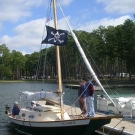
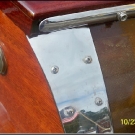
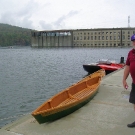
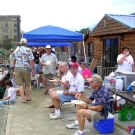
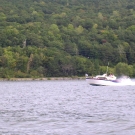
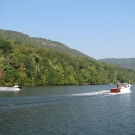
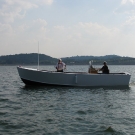

Other than “how much does it cost?” and “how long will it take?”, most questions we receive concern wood and plywood. We will be adding the answers to as many of these questions as we can on the FAQ’s page. As always, we invite your input.
Woods for boat building
Plywood for boat building
APA Technical sheets
The following are Technical data sheets from the American Plywood Association. Plywood grading in the US is not regulated by the Federal Government, but is a voluntary set of standards administered by APA.
The most common questions asked about boat building wood and plywood
A: We have a List of lumber suppliers on our web site that may have a source, however, long sheets are not required. Standard 4′ x 8′ sheets can be joined using either a scarf joint or a butt block. We rarely use long sheets anymore; we normally use a butt block. Structurally, this is equal to or stronger than a full-length sheet if properly done. See: Joining plywood to make longer sheets for a description of making a scarf and butt joint.
2
Q: I can’t find marine plywood, can I use AB plywood? That’s all my building supplies center carries.
A: First, you’re shopping in the wrong place. Building centers are great, but they don’t normally sell many low volume items. Go to a real lumberyard. Not all plans call out marine plywood. Small rowboats and other small designs frequently give ABX (exterior) as an option. The “AB” designation means that there are no open knots on the surfaces. When marine is called for, it is usually only called out for planking; not for the transom, gussets, knees, stem, or breasthook. Marine is important when the plywood will be bent. Marine plywood has no voids running across the panel, exterior does. Picture a 1/4″ or 3/8″ panel (3 plies) with a 1/2″ gap running across the panel. This means that more than 1/3″ of the thickness is air. If the bend is particularly pronounced at this point or there is a lot of stress, it could fracture at the void. So what do you do if you can’t get marine? That’s your call. If the boat you intend to build is a high speed boat that will take a lot of pounding, do you want to take the chance. OPTIONS: If you live in Timbuktu, can’t get marine, choose the best ABX you can find (check edges for voids). Put the best sheets in the forward sections. If you have a choice, use marine if called for. For planking applications, AC is not desireable because of the open knots which allow water to enter the center plies. To properly fill the knots (epoxy fillers), is more work and expense than buying the proper material.
3
Q: I can’t find pieces of lumber long enough for my boat, what do I do?
A: First, read above about “real lumberyards”. OPTIONS: Join shorter pieces. Make the joint in the aft section, where there is less bending. Use a scarf joint or butt joint backed with a butt block. Scarf joint: use a joint ratio of 1:8 to 1:12. Butt joint: Butt between frames backed up with material of the same thickness, from frame to frame. If there is any curve in the member, bend a temporary longer piece in position and plane the butt block to match the arc. If this is not done, a flat spot will result.
4
Q: Can I use plywood to make my frames instead of lumber?
A: Not recommended. Fasteners do not hold well in the edge-grain of plywood. It is also difficult to seal the edges of all the frames so that they will not begin to swell and crack.
5
Q: I can’t find mahogany or white oak as called for in my plans. What do I do?
A: There are other types of wood that can be used. “Marine lumbers” have certain characteristics: glueability, hold fasteners well, resistant to rot, relatively strong. Other woods: Douglas-fir, long-leaf yellow pine (old growth), cypress. There are some eucalyptus (available in Australia) that are excellent for boatbuilding. Several cedars and spruces are good for small, lightweight, boats. I will not attempt to list all the woods that could be used (not that I could). Be reasonable about this. If you are going to build a small rowboat that won’t go out much, use another straight-grained hardwood. As long as it is well sealed, dry-rot should not be a problem. Whenever you purchase wood for boatbuilding, look at the edges. If the grain runs parallel to the surfaces, it is less likely to break than wood where the grain runs diagonal to the surfaces. Straight-grained (boring looking) wood is always desirable for structural applications. If your boat is kept under cover, if you are really good about maintenance, keep a good paint job on the wood, if you don’t care if it lasts more than a year… you may not have to worry about rot.
“Riviera… The frames and stringers have been made from Nyatoh (Palaquium spp. and Payena spp.), an Indonesian hardwood commonly utilised for boat building in this part of the world.” – Andrew Tainsh, Perth, Western Australia
“Riviera… The frame is made of Blue Gum (Eucalyptus globulus) and Messmate, which are both local eucalypts. Both have simillar strength, density and working properties to Mahogany,and have been used in boats here for many years.” – Craig Strike, Victoria, Australia
From Wood Technical Fact Sheet at US Forest Products Laboratory:
“Dryobalanops spp (Keladan, Kapur, Kapoer, Borneo camphorwood): Uses: Heavy construction work, furniture components, flooring, cores and backs of plywood (glues well with urea formaldehyde), boat framing, joinery.”
6
Q: Can I use _______ to build my boat?
A: You can use anything you want to build your boat. As Allyn says, “It ain’t my boat”. There are builders who use any number of woods that are not considered good boat building material, many never have problems with them; but we are boat designers, and will not recommend materials that we think are inferior. If you deviate from the materials list, be reasonable. If you are using inferior materials, just because they are cheaper, this is false economy.
7
Q: My chines/sheers keep breaking, what do I do?
A: This can be caused by over-drying of the wood or using material that has diagonal edge grain. If you are using “diagonal-grain” material, use it where it will not be stressed. Use parallel grain in the forward section. OPTION: Most often longitudinals can be finessed into position by using boiling water. 1) Clamp the piece to the frames and pull the forward end of the piece toward the stem and tie in place. 2) Wrap the bending part with towels and pour on boiling water. 3) Allow to sit overnight. This will usually do it, but you can increase the tension and repeat if you feel it is necessary. You shouldn’t find it necessary to steam any piece on a Glen-L design.
Whether you are working with lumber or plywood, remember that you are working with organic materials, materials that may be old growth or new, may have had periods of rapid growth or slow, depending on climate. Why are you having problems when others don’t… lucky? Old-time carpenters look at the lumber they use, they don’t accept the pieces on the top of the pile. They look carefully for the characteristics that make them best suitable for the job they are doing. Buying your materials from someone who specializes in them allows you to take advantage of their knowledge and expertise, and can save you a lot of time and money.
8
Q: I am having trouble bending the plywood planking in the forward sections, what do I do?
A: Use the towels-boiling water-overnight treatment above. Put a piece of wood on either side of the pointy-end of the panel to spread the stress, clamp with a C-clamp, pull toward position, tie off with rope. This can be repeated if necessary.
9
Q: I used marine plywood in the forward bottom and exterior plywood aft, they are different thicknesses, what do I do?
A: This is an akward question. The answer is, don’t find yourself in this position. Increasingly you will find scant plywood available. Scant is 1/32″ less than the nominal thickness. Why do they do this? To make more money. When you are purchasing plywood, just be aware that scant is out there. If you ask, you want “full thickness, not scant plywood”. Any “cure” for the problem after the plywood is installed will be “Mickey Mouse”.
[…] you concerned with finding the correct type and quality of plywood to build your boat? Today’s article by Ken Hankinson should clear up some of your questions. […]
[…] have a section on our website – Wood & Plywood – pages in which we have reproduced Chapter 5 from our book Boatbuilding With Plywood. This […]